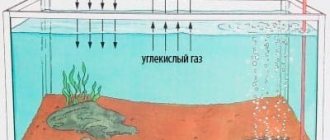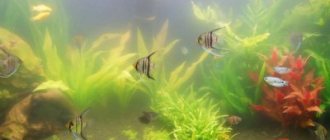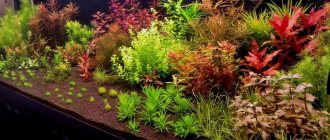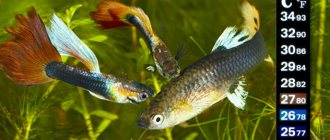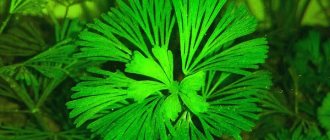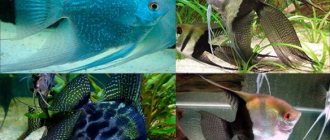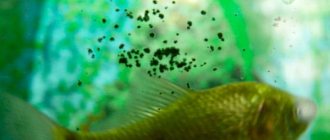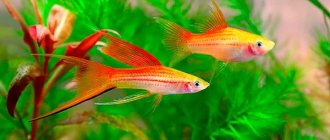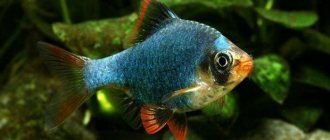Newts in the aquarium
Newts are a general designation for a group of representatives of tailed amphibians, which includes about 20 genera, which, in turn, are divided into many species and subspecies. Not all of them are suitable for keeping in a home aquarium. Let's figure out which newts can be kept in a home aquarium and what conditions are needed for this.
There are three types of newts most often kept in aquariums: common, spiny and crested.
Let's talk in more detail about each of them:
Common newt (Lissotriton vulgaris)
Common newt photo
The common newt belongs to the genus of small newts and is listed in the Red Book of Russia. Sizes from 7 to 11 centimeters, body color from olive to brown, abdomen yellowish or light orange. Sex differences are weak most of the time, males are slightly larger than females. Distinctive features become visible during the mating season - males develop a crest. The conditions for keeping it in the aquarium are as follows:
— Aquarium volume for a newt : from 15 liters, it is better, of course, more, especially if you plan to keep the newt not alone, but in a group of relatives or in the vicinity of fish. It is necessary to equip one or more islands, since newts are amphibious animals that come to land from time to time.
An ideal option would be a special Tetra ReptoAquaSet .
Aquarium for newts
And the bottomless range of REPTI-ZOO products in the attached catalog will help you in arranging your aquarium; you will find everything you need for newts: soils, islands, plants, heating pads, lamps, etc. (the catalog is huge, it takes 2-5 seconds to load, we recommend downloading it to your computer).
— Water temperature for newt. Newts are cold-water creatures. The required water temperature for keeping them is 18 - 22 degrees Celsius. And if you want to bring the newt’s living conditions as close as possible to natural ones, then to organize the wintering period, the water in the aquarium will have to be cooled to 5-8 degrees. Therefore, think about cooling the water in the aquarium in advance.
- Acidity. The pH range of newts is very wide; they live in both acidic (5.5) and almost alkaline water (7.8), but it must be remembered that, as with keeping fish, the unacceptable range of values is more important, but the stability of the indicator. Sudden changes in pH are tolerated very poorly by any living creature.
— Water hardness for Triton . They prefer either soft or medium-hard water, dH range from 5 to 15.
— Lighting for newt . The issue of lighting for the newts themselves is not fundamental, but it is still required for the vegetation in the aquarium. When designing the lighting for the newts' future home, remember that the lamp must be positioned so that it does not heat the water!
Common newt photo
— Soil for newt. The issue of soil is extremely important. Remember: you need to choose a soil fraction such that individual particles cannot fit into the newt’s mouth. Otherwise, accidental consumption of soil is possible, which will most likely lead to intestinal obstruction and death of the pet.
— Plants for newt. It is preferable to use live plants, because this makes your aquarium more natural, both aesthetically and biologically, living plants play an important role in the functioning of the nitrogen cycle in the aquarium , and if you decide to breed newts, then you cannot do without living plants at all, the female spawns in them, then tucks up the leaves, providing protection for the offspring, and the young newts hide in dense thickets.
— Filtration. Here, the recommendations for keeping fish and newts in an aquarium are the same: the filter should pump 6-10 volumes of the aquarium per hour.
— Water changes. Different sources contain different recommendations for water changes, from 15 to 30% of water per week. We think that in this case it is correct to take the average value of 20% and focus on the individual characteristics of your aquarium.
A cover glass is required, otherwise the pet may escape from the aquarium into the “big world”.
Types of newts
Among the many varieties of newts, scientists distinguish two broad groups: aquatic newts and amphibians. Each group includes several subspecies, among which the spiny, crested and red newt are popular among aquarists.
Popular types of newts:
- The Spanish (spiny) amphibian is one of the most beloved species of aquarists. The body length of the Spanish variety reaches 25-30 cm, the color combines shades of yellow, black and gray. The Spanish representative is suitable for beginners, as it is unpretentious and does not require the construction of a dry area in the tank. An aquarium for spiny newts is suitable with a capacity of 50-60 liters.
- Dwarf newt - the dwarf variety is popularly referred to as the “red newt” because of its rich color. The abdomen of the dwarf amphibian has a scarlet or orange tint, on which there are dark spots. Caring for a newt of this species is easy: the amphibian will need a small area of land in a tank, and water temperatures in the range of 20-24C. It should be noted that representatives of this species are aggressive and will not get along with other pets.
- Common - reaches a length of up to 12 cm, the color is represented by a brownish-olive background with dark spots. Males have a well-developed crest. Despite the unpretentiousness and accessibility of ordinary amphibians, these representatives are timid and do not make contact with the owner.
- The crested amphibian has rough brown skin on which warts are located. During breeding, males of the crested variety acquire a sharp, raised crest. It is impossible to keep a crested amphibian with fish, since the skin glands of the newt secrete a toxic substance.
- Eastern American variety, or red newt - the amphibian received its second name because of its juicy, rich color. Representatives of this species are colored yellow-green or scarlet-orange, and in times of danger they secrete a toxic substance from the skin glands. The amphibian reaches 9-12 cm in length.
- Warty Chinese - has chestnut skin with yellow or orange spots; representatives with a bright stripe on the back are rarely found. The skin of the Chinese variety is covered with warts, which is why the species got its name. The amphibian grows up to 16 cm in length. The warty newt in an aquarium prefers powerful aeration and filtration.
- Crocodile - this type of amphibian is unusually beautiful: the body of newts is black, the tail is orange, the body is covered with a bright stripe along the back and spots in the form of warts. The skin of the crocodile newt is shiny. Representatives of this species reach 17 cm in length. At home, when keeping a crocodile amphibian, a large area of land is built for the pet.
The above varieties are considered common and often become pets. However, there are other, rarer species, some of which are even listed in the Red Book:
- Marbled appearance - has a black belly, on which light spots are randomly located. The main background of the body is olive with dark splashes, which is why the look is called “marble.” Body length – up to 17 cm.
- The Iranian or Zagros species is a very expensive and rare representative. The high price is due to its incredible appearance: the color combines light, red and dark tones. In addition, the Iranian variety is protected, and the specimens that go on sale are picky about their maintenance conditions.
Feeding newts in the aquarium
Feeding newts
Newts are predators, they will be happy to eat small live fish, crickets, earthworms, common newt and other small species, and young newts eat frozen bloodworms well. If for some reason you cannot feed your pet live food, use pieces of lean fish, for example, haddock, cod or shrimp. Young animals are fed every day, adults 2-3 times a week. It is also recommended to occasionally give vitamin supplements and calcium supplements. Calcium supplements can be replaced with crushed eggshells, but it is better not to skimp on your pet’s health.
Food for newts Tetra
In addition to live food, it is recommended to introduce freeze-dried food from trusted brands into the newt diet. They are easy to use and contain all the necessary nutritional elements for your animal. One of the best foods is Tetra ReptoFrog Granules - a complete food for aquatic frogs and newts.
What do newts eat in an aquarium environment?
Newt is a predator , so the food must be suitable. Tadpoles, small fish, invertebrates, and larvae are included in the main diet of aquarium newts at home. In pet stores you can buy mosquito larvae, bloodworms or insects for your pet. If you decide to feed your pet these products at home, they must first be washed with warm water. And also, they love to eat with pleasure ordinary snails, worms, shrimp and the like.
What to feed a newt if it is not possible to buy fresh food from the diet? In this case, it is possible to eat frozen fish, squid, raw meat, chicken, and liver. These foods must be divided into small pieces so that he can swallow, otherwise he will choke. Young amphibians are able to eat once a day, and older individuals - once every two days. An adult can go without food for up to 4 days. At first, you need to feed the new individual using tweezers. Sometimes you will need to actively shake the tweezers in front of the newt to get its attention.
Depending on the individual, you will have to try different food before choosing the ideal food. Worms (frozen or live) seem to be a favorite among pets' favorite treats. Newts can also eat earthworms, brine shrimp, glass shrimp, and daphnia. Floating sticks can also be fed to reptiles, although many representatives refuse them.
Greater newts, especially the larger Japanese species, may also consume small lizards . It may take a bit of testing to figure out how much and how a particular specimen should be fed, judging this by their size and body condition - fat or skinny, and whether there is food left in the tank (which will cause toxins to form) and take timely measures.
Keeping newts together with fish
Newts with fish photo
There are several problems in keeping a newt together with fish, already described above in this article:
Newts are cold-water, and most tropical aquarium fish love warm water, plus for the winter you will have to arrange a separate aquarium for the newt, because at +6 not a single tropical fish will live. The temperature of +22 is suitable for neons, but here we have a second problem...
Predator newts. And neons , as an “Amazonian snack,” are also great for them. A large goldfish can be a perfectly acceptable neighbor for a newt: it tolerates cold water well, and will not fit into its mouth even if it wants to. But it should be borne in mind that large goldfish require a completely different aquarium volume and filtration power.
Breeding
At home, the common newt reproduces actively and without much difficulty. The mating season occurs in the spring, after leaving wintering grounds in March-July. At this time, the common newt changes: a comb appears on the back, the color becomes brighter.
During this period, you can transplant the male and female into a terrarium prepared for breeding. Temperature is about 18°C. Reproduction occurs through internal fertilization: the male lays spermatophores, which are then found by the female. The pregnant female is placed in a terrarium with abundant vegetation. She spawns directly on the leaves, wrapping each egg in a separate leaf. In total, during this time she lays several hundred eggs.
Newt larvae hatch in 20-30 days. At about three months they begin to take on the appearance of an adult. During the development of the larvae, it is important to maintain sufficient shade in the terrarium and provide shelter. Naturally, you cannot introduce fish to young newts - many of them are quite capable of considering amphibians as food.
Return to content
Diseases of newts in the aquarium
Newts, like fish, unfortunately, sometimes get sick. They can be affected by both fungal (most often saprolegniosis and mucorosis), and parasitic and infectious diseases. A common and dangerous infectious disease of newts is the so-called “red leg”, in fact, it is sepsis, and it is called red leg because one of the symptoms is hemorrhages under the skin of the abdomen and upper parts of the legs, from which they acquire a color from pink to bright red color. Other symptoms may also include wounds on the skin; if the newt gets out of the water and dries out a little, then around the wounds you can see a black border, lethargy, even complete apathy, and refusal to eat.
The disease requires immediate treatment: if a sick newt lives with relatives, it must be isolated in a quarantine container, since the disease is contagious. Next, it is best to find a veterinary laboratory where they can do tests to understand which pathogen is responsible for the occurrence of sepsis in a particular case, so as not to poison the newt with an antibiotic to which the microbes may be insensitive. If it is not possible to perform an analysis, then there is no other way - the antibiotic will have to be selected empirically (experimentally): almost all antibiotics from the human first aid kit can be used in treatment, but most often tetracycline is used, at a dose of 50 mg/kg of animal weight through the mouth with food, aminoglycosides (amikacin, gentamicin) 20 mg/kg body weight or metronidazole (Trichopol) at a dose of 50-100 mg/kg for 5-7 days. There are also more complex methods - introducing a solution of chloraphenicol into the stomach of an amphibian through a probe. The dosage is as follows: the first administration of 8 mg of the drug in 2 ml of water, then for 6 days the administration of 4 mg of the drug in 1 ml of water, and then the prophylactic administration of a similar dose of chloraphenicol once a week for several weeks. It is possible to use medicinal baths, 15 ml of sulfadimidine solution per 10 liters of water. The duration of the bath is 1 hour, baths last for two weeks. In the event of an epidemic, complete disinfection and restart of the aquarium is necessary.
How do newts spend the winter?
These amphibians lead an unusual lifestyle, alternating periods of living in water and on land. Representatives of some varieties require a period of “rest,” the so-called “wintering.” Thanks to it, individuals move from the terrestrial phase of life to the aquatic phase, when they need to leave offspring, without much discomfort.
Spanish and dwarf dragons can do without hibernation. But for the rest, this life period is necessary, otherwise they will not be able to spawn, the life cycle will fail, and the newt will live much shorter.
For “dragons,” hibernation most often occurs in the fall and lasts about 8-9 weeks. And if it is necessary to ensure that the pet’s life processes slow down at home, the owner needs to do the following:
- over 12-14 days, gradually lower the temperature of the aquatic environment to 10°-15°C and reduce the duration of daylight hours;
- after this, the pets must be placed in a cage in moist sphagnum, leaving it like that for 3-4 days;
- then place the container with newts in the refrigerator, where the temperature is not too low - in the door compartment or vegetable department for 6-8 weeks.
While your pets are sleeping, you should maintain the humidity of the substrate and sometimes give the animals food, because in some species, snacking during hibernation is quite normal.
Newts emerge from hibernation gradually; for this it is necessary to increase the temperature and the duration of the photoperiod. Pets should be provided with nutritious food and access to water, in which some male newts begin to grow an attractive crest, they begin to care for females and give birth.
Spine newt, also known as ribbed newt (Pleurodeles waltl)
Mud ribbed newt photo
The conditions for keeping the spiny newt are not much different from the ordinary one, however, it is worth considering that Pleurodeles waltl is much larger (up to 23 centimeters), accordingly, it needs a larger aquarium. Females of this species are usually larger than males, but they have a shorter tail.
Mud ribbed newt photo
When keeping this species, it should be taken into account that they have pointed ends of the ribs on their sides, which, when in danger, secrete a poisonous, very burning substance. It can damage the skin, and in some people cause an allergic reaction, even fatal, so it is better not to touch the ribbed newt with your bare hands.
Crested newt (Triturus cristatus)
Crested newt photo
In size, this is the average type of newt of the three described, they grow up to 18 cm, the body is brown to black in color, and the abdomen is orange. Very similar to the common newt, you can distinguish it by its crest. The crested newt has an intermittent crest, while the common newt has a continuous crest.
Crested newt photo
The skin of this newt has poisonous glands, the effect of the poison is similar to that of the spiny newt.
Spanish newt and confusion
Newt Spanish photo
There is a lot of confusion regarding the Spanish triton in Russia. The fact is that throughout the post-Soviet space, various species are sold under the guise of the Spanish newt. The above-described spiny (ribbed) newt Pleurodeles waltl is most often sold under the sign “Spanish newt”.
Newt Spanish photo
The real Spanish newt (Lissotriton boscai) is found exclusively on the Iberian Peninsula, Spain and Portugal, that is, it is endemic, included in the Berne Convention, protected by Spanish law, and is not found in our area at all.
All of the above is just the fruit of observing this type of amphibian and collecting various information from owners and breeders. We would like to share with visitors not only information, but also live emotions that allow us to understand the world of aquariums more fully and subtly. Register at https://fanfishka.ru/forum/ , participate in discussions on the forum, create profile topics where you will talk about your pets in the first person and first-hand, describe their habits, behavioral features and content, and share with us your successes and joys, share your experiences and learn from the experiences of others. We are interested in every bit of your experience, every second of your joy, every awareness of a mistake, which makes it possible for your comrades to avoid the same mistake. The more of us there are, the more pure and transparent drops of goodness there are in the life and everyday life of our seven billion society.
Author of the article: Mikhail Okatiev Astario

